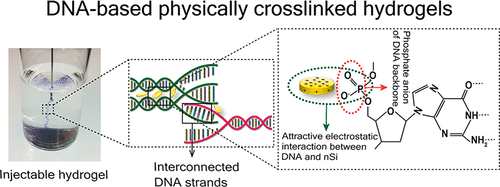Our official English website, www.x-mol.net, welcomes your
feedback! (Note: you will need to create a separate account there.)
Harnessing the Noncovalent Interactions of DNA Backbone with 2D Silicate Nanodisks To Fabricate Injectable Therapeutic Hydrogels
ACS Nano ( IF 15.8 ) Pub Date : 2018-09-06 00:00:00 , DOI: 10.1021/acsnano.8b02434 Sayantani Basu 1 , Settimio Pacelli 1 , Yi Feng 2 , Qinghua Lu 2 , Jinxi Wang 2 , Arghya Paul 1
ACS Nano ( IF 15.8 ) Pub Date : 2018-09-06 00:00:00 , DOI: 10.1021/acsnano.8b02434 Sayantani Basu 1 , Settimio Pacelli 1 , Yi Feng 2 , Qinghua Lu 2 , Jinxi Wang 2 , Arghya Paul 1
Affiliation

|
Injectable hydrogels present several advantages over prefabricated scaffolds including ease of delivery, shear-thinning property, and broad applicability in the fields of drug delivery and tissue engineering. Here, we report an approach to develop injectable hydrogels with sustained drug release properties, exploiting the chemical nature of the DNA backbone and silicate nanodisks. A two-step gelation method is implemented for generating a combination of noncovalent network points, leading to a physically cross-linked hydrogel. The first step initiates the development of an interconnected structure by utilizing DNA denaturation and rehybridization mechanism to form hydrogen bonds between complementary base pairs of neighboring DNA strands. The anisotropic charge distribution of two-dimensional silicate nanodisks (nSi) makes them an active center in the second step of the gelation process. Silicate nanodisks create additional network points via attractive electrostatic interactions with the DNA backbone, thereby enhancing the mechanical resilience of the formulated hydrogel. The thermally stable hydrogels displayed an increase in elasticity and yield stress as a function of nSi concentration. They were able to form self-supporting structures post injection due to their rapid recovery after removal of cyclic stress. Moreover, the presence of nanosilicate was shown to modulate the release of a model osteogenic drug dexamethasone (Dex). The bioactivity of released Dex was confirmed from in vitro osteogenic differentiation of human adipose stem cells and in vivo bone formation in a rat cranial bone defect model. Overall, our DNA-based nanocomposite hydrogel obtained from a combination of noncovalent network points can serve as an injectable material for bone regeneration and carrier for sustained release of therapeutics.
中文翻译:

利用2D硅酸盐纳米磁盘利用DNA骨架的非共价相互作用来制备可注射的治疗性水凝胶。
与预制支架相比,可注射水凝胶具有多种优势,包括易于运输,剪切稀化特性以及在药物输送和组织工程领域的广泛适用性。在这里,我们报告了一种利用DNA骨架和硅酸盐纳米盘的化学性质开发具有持续药物释放特性的可注射水凝胶的方法。实现了两步凝胶化方法,以生成非共价网络点的组合,从而形成物理交联的水凝胶。第一步通过利用DNA变性和再杂交机制在相邻DNA链的互补碱基对之间形成氢键来启动互连结构的开发。二维硅酸盐纳米盘(nSi)的各向异性电荷分布使它们成为凝胶过程第二步中的活性中心。硅酸盐纳米磁盘可创建其他网络点通过与DNA骨架的有吸引力的静电相互作用,从而增强了配制水凝胶的机械弹性。热稳定的水凝胶显示出作为nSi浓度的函数的弹性和屈服应力的增加。由于能够在消除循环应力后迅速恢复,因此它们能够在注射后形成自支撑结构。此外,显示出纳米硅酸盐的存在可调节模型成骨药物地塞米松(Dex)的释放。从人脂肪干细胞的体外成骨分化和体内证实了释放的Dex的生物活性。大鼠颅骨缺损模型中的骨形成。总体而言,我们从非共价网络点的组合中获得的基于DNA的纳米复合水凝胶可以用作骨再生的注射材料和治疗剂的持续释放载体。
更新日期:2018-09-06
中文翻译:

利用2D硅酸盐纳米磁盘利用DNA骨架的非共价相互作用来制备可注射的治疗性水凝胶。
与预制支架相比,可注射水凝胶具有多种优势,包括易于运输,剪切稀化特性以及在药物输送和组织工程领域的广泛适用性。在这里,我们报告了一种利用DNA骨架和硅酸盐纳米盘的化学性质开发具有持续药物释放特性的可注射水凝胶的方法。实现了两步凝胶化方法,以生成非共价网络点的组合,从而形成物理交联的水凝胶。第一步通过利用DNA变性和再杂交机制在相邻DNA链的互补碱基对之间形成氢键来启动互连结构的开发。二维硅酸盐纳米盘(nSi)的各向异性电荷分布使它们成为凝胶过程第二步中的活性中心。硅酸盐纳米磁盘可创建其他网络点通过与DNA骨架的有吸引力的静电相互作用,从而增强了配制水凝胶的机械弹性。热稳定的水凝胶显示出作为nSi浓度的函数的弹性和屈服应力的增加。由于能够在消除循环应力后迅速恢复,因此它们能够在注射后形成自支撑结构。此外,显示出纳米硅酸盐的存在可调节模型成骨药物地塞米松(Dex)的释放。从人脂肪干细胞的体外成骨分化和体内证实了释放的Dex的生物活性。大鼠颅骨缺损模型中的骨形成。总体而言,我们从非共价网络点的组合中获得的基于DNA的纳米复合水凝胶可以用作骨再生的注射材料和治疗剂的持续释放载体。











































 京公网安备 11010802027423号
京公网安备 11010802027423号